The Be Quiet! Silent Loop 2 AIO Cooler Review: Quiet and Unassuming
by E. Fylladitakis on September 7, 2023 9:30 AM ESTTesting Results, Maximum Fan Speed
Our maximum speed testing is performed with both the fans and the pump of the kit powered via a 12V DC source. This input voltage should have the pump and fans matching the speed ratings of the manufacturer. The Silent Wings 3 fans rotate at just a little below their rated speed, with our tachometer reading 1590 RPM. We got the exact same speed readings from both fans, a hint of good manufacturing consistency.

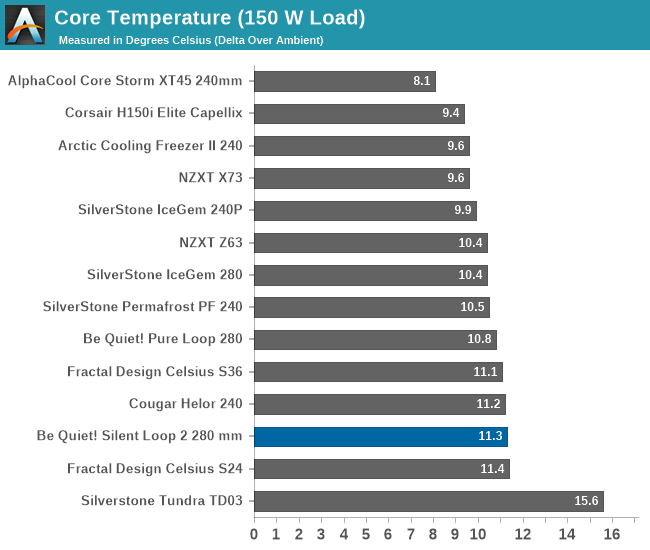
| Core Temperature, Constant Thermal Load (Max Fan Speed) |
The thermal performance of the Silent Loop 2 280 mm cooler initially appears unimpressive in comparison to other AIO coolers of similar size. The average thermal resistance of 0.081 °C/W may be adequate for a modern CPU, but is a figure that many other similarly sized – and even smaller – products can achieve. That includes Be Quiet!’s older Pure Loop range of AIO coolers.
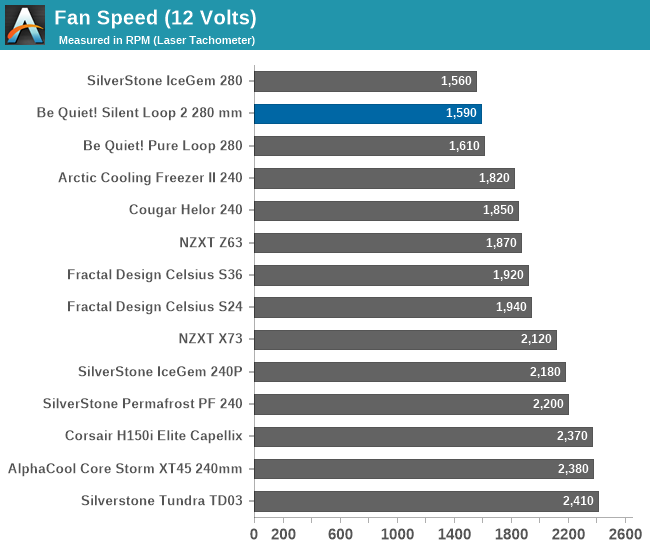
In complete contradiction to the thermal performance results, the acoustics performance of the Silent Loop 2 is exceptional. With both of its fans at maximum speed, our meter took a reading of just 37.4 dB(A). It is an audible figure but one that would be comfortable for typical daytime use. We could not discern any noise coming from the liquid pump at all.
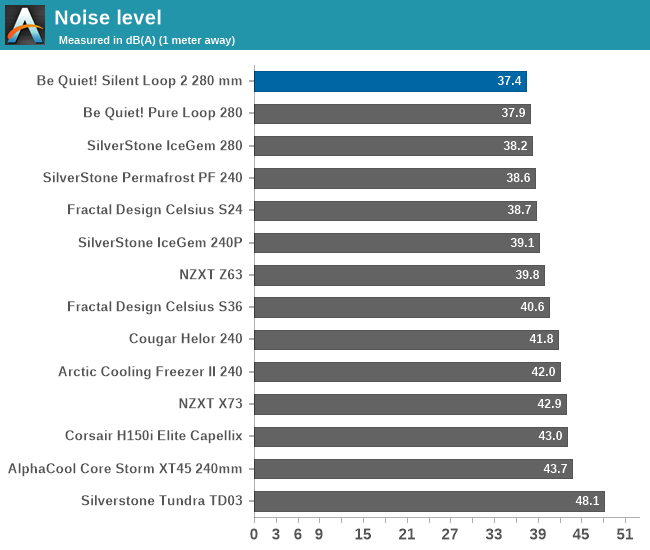
Testing Results, Low Fan Speed
Using a PWM voltage regulator, we reduced the speed of the fans manually down to half their rated speed, which is 800 RPM for the Silent Wings 3 140 mm fans. The pump was also connected to the same power source, functioning properly at this low speed setting.


| Core Temperature, Constant Thermal Load (Low Fan Speed) |
Thermally, the results indicate that the Silent Loop 2 performs similarly to other comparable AIO cooler designs, yet is a step behind most. The average thermal permittance of 0.1026 °C/W is a good figure but hardly impressive for a 280 mm liquid cooler. At first sight, one can discern that even some designs with 240 mm radiators perform better – however, a closer look reveals that the fans of the Silent Loop 2 rotate at a very low speed during this test.
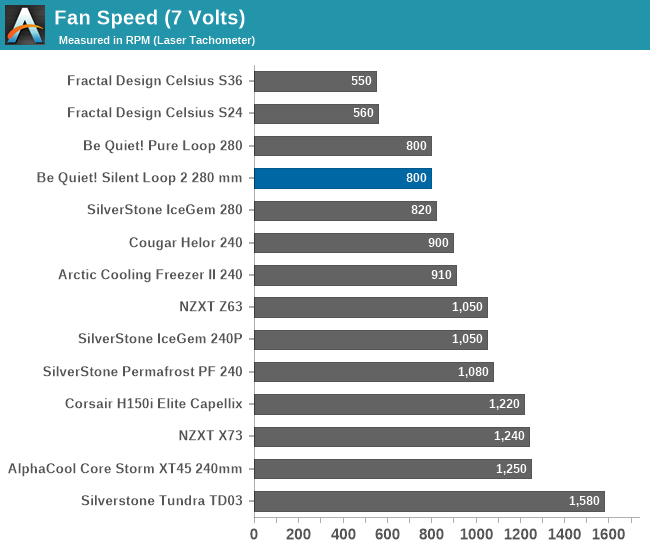
Much like our previous tests, the noise output of the Be Quiet! Silent Loop 2 under these operating conditions is extremely low, at just 32.1 dB(A). To regular human ears, this is entirely inaudible from a distance of one meter. There also is no noise coming from the main block assembly at all, with the pump managing to operate without even the slightest hydrodynamic noise coming from it. Although the Be Quiet! Silent Loop 2 does not sit all by itself at the top of the chart, 32.1 dB(A) is the lowest sound pressure level figure we have recorded from AIO coolers to this date.
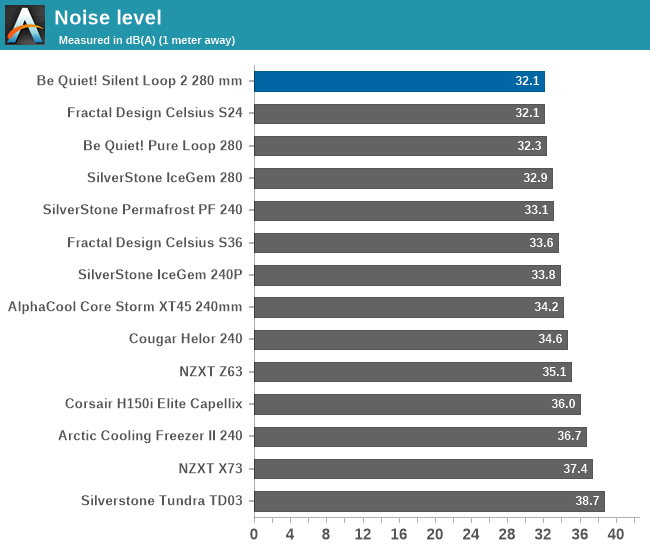
Thermal Resistance VS Sound Pressure Level
During our thermal resistance vs. sound pressure level test, we maintain a steady 100W thermal load and assess the overall performance of the coolers by taking multiple temperatures and sound pressure level readings within the operating range of the stock cooling fans. The result is a graph that depicts the absolute thermal resistance of the cooler in comparison to the noise generated. For both the sound pressure level and absolute thermal resistance readings, lower figures are better.
This graph reveals the true strength of the Silent Loop 2 AIO cooler, which is no other than silent operation. The thermal resistance range of the cooler is small, suggesting that only a significant change in the speed of its fans would make a tangible performance difference. Regardless, the Silent Loop 2 achieves these thermal resistance figures at significantly lower dB(A) than other similarly sized AIO coolers. Only custom liquid cooling kits that are significantly more powerful (and expensive) have a notable performance edge over the Silent Loop 2.


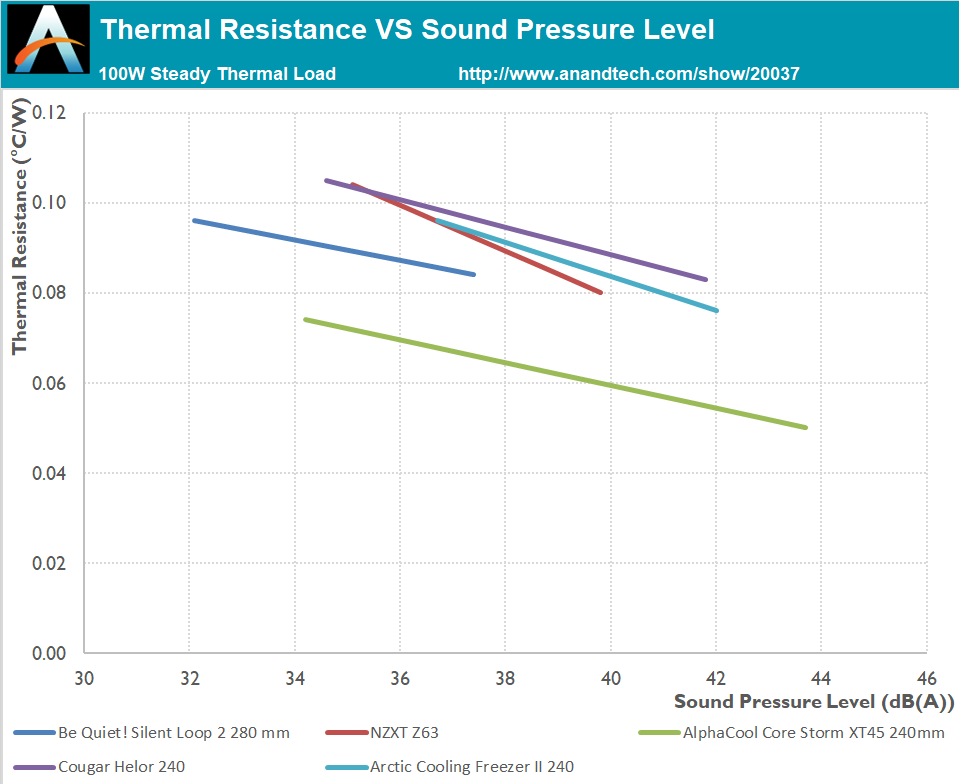








22 Comments
View All Comments
osteopathic1 - Thursday, September 7, 2023 - link
Thanks for the review. I have been looking for an AIO but dont want fancy or RGB festooned devices. This fits the bill.Kevinlangford - Thursday, September 7, 2023 - link
is $207 a good starting point for a cooler?meacupla - Thursday, September 7, 2023 - link
$207(USD) for a 280mm/360mm size AIO is on the extremely expensive side.280mm/360mm typically cost half that, even when sticking to recognizable brands like Deepcool and MSI.
In fact, it is cheaper still to buy an average cost 280/360mm and then attach noctua sterrox fans onto that.
osteopathic1 - Friday, September 8, 2023 - link
Thanks for the head's up.deporter - Thursday, September 7, 2023 - link
Thanks for the review, it's mostly well done. But I take issue with this statement: "just 32.1 dB(A). To regular human ears, this is entirely inaudible from a distance of one meter."First of all, why say from a distance of one meter, if the measurement is already at one meter?
But most importantly, 32.1dB(A) does not mean entirely inaudible. The hearing threshold for humans is at around 0dB.
And if you want to measure quiet gear, you need a very quiet room and some equipment which can detect very low SPL levels. That's a bit expensive, though, so I feel your pain.
evilspoons - Thursday, September 7, 2023 - link
If we assume the measurement was taken completely perfectly (I know this is not reasonable) it is still likely that 32.1 dB(A) is below the noise floor of almost everyone's rooms, rendering it effectively inaudible.meacupla - Thursday, September 7, 2023 - link
Not only that, most consumer grade sound measuring devices only go down to around 30dBA.And then there is the pitch of the sound, which requires a very expensive professional grade device to measure.
deporter - Friday, September 8, 2023 - link
>it is still likely that 32.1 dB(A) is below the noise floor of almost everyone's roomsNo, not at all. With the windows closed, in the evenings, a room is definitely quieter than 32dB(A), unless there's a source of noise present inside. Look at various sound level charts to get an idea, or get a good SPL meter (but as I said, the good ones that measure low are expensive).
Ryan Smith - Friday, September 8, 2023 - link
For what it's worth, as a suburbanite, I've never been able to do better than 30dB(A). And that was on a snowy night. Otherwise 31dB(A) is the normal floor around here. The experience has been similar for other AT editors.ballsystemlord - Saturday, September 16, 2023 - link
Living in a rural area, IE where there are few people around, I can tell you that the noise floor here is about 30db. I have measured it with a decibel meter.The noise that enters the house at night is a combination of the cicadas and the road noise from a 2 lane road about 1400ft away.
And those cicadas are loud! I should measure how loud someday, but really, it can hurt your ears if you're outside of the house.